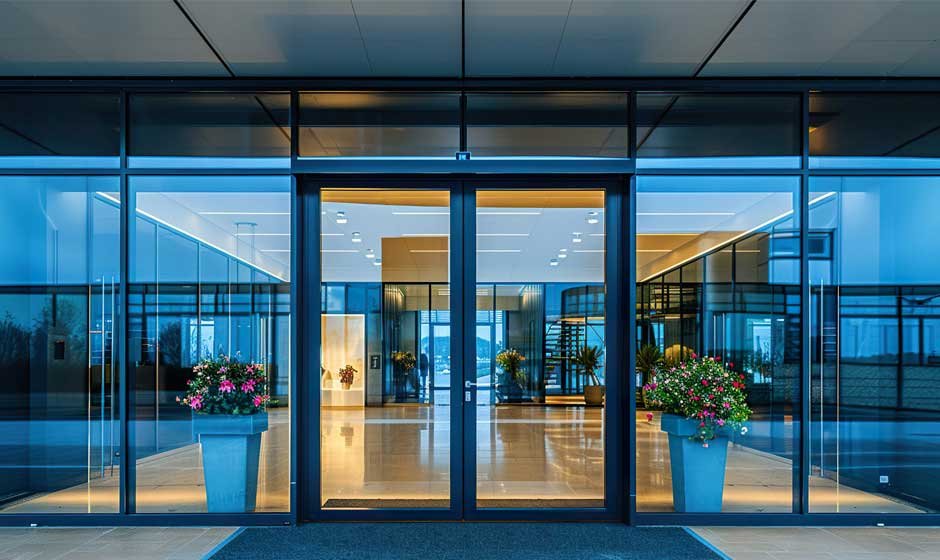A commercial building’s entrance is much more than just a doorway; it’s a visual handshake that sets the tone for what lies beyond. For businesses, the entrance serves as the first physical interaction customers, clients, and visitors have with their establishment. The right commercial entrance door can communicate professionalism, safety, and aesthetic appeal, influencing the perception of the brand before a single word is exchanged. Below, we explore the multifaceted role of commercial entrance doors in creating a lasting first impression.
The Intersection of Functionality and Aesthetics
Commercial entrance doors must strike a delicate balance between functionality and aesthetics. From the moment someone approaches a building, the entrance door becomes a focal point, reflecting the values and identity of the business. A sleek, modern glass door might suggest innovation and transparency, while a sturdy, industrial door can project reliability and strength.
Design choices, including materials, finishes, and hardware, significantly impact the perception of the space. For example, doors with clean lines and contemporary materials like aluminum or stainless steel often appeal to tech-forward companies, whereas natural wood finishes might complement establishments with a more traditional or boutique feel. Beyond appearances, features such as smooth operation, weather resistance, and proper insulation also contribute to a door’s overall quality, ensuring that the first impression is both impactful and enduring.
Choosing the right commercial door involves more than aesthetic considerations. Practical factors like security, accessibility, and compliance with regulations must be addressed to ensure the door functions seamlessly. For insights into key considerations when purchasing a commercial entrance door, industry leaders like USA Fire Door provide expert guidance on selecting doors that meet both visual and operational needs.
Setting the Tone for Customer Experience
The entrance door is often the first touchpoint in a customer’s journey, and its impact cannot be overstated. A well-designed entrance creates an inviting atmosphere, encouraging potential customers to step inside and explore further. Conversely, an outdated or poorly maintained door can deter visitors, no matter how exceptional the service or product offering might be inside.
Automatic sliding doors, for instance, are particularly popular in retail and hospitality environments. They convey convenience and modernity while accommodating high foot traffic and accessibility needs. On the other hand, heavy, manually operated doors can present an air of exclusivity, often seen in upscale restaurants or private offices. Every detail—from the sound a door makes when it closes to the feel of its handle—affects a customer’s perception.
Moreover, the psychology of design plays a significant role. Studies show that the human brain processes environmental cues quickly, making judgments within seconds. A polished, welcoming entrance helps foster trust and confidence, reinforcing the brand’s message even before a word of interaction takes place.
Enhancing Brand Identity
A commercial entrance door does more than just facilitate entry; it acts as an extension of a business’s brand identity. The design elements of a door can echo a company’s values, mission, and culture. For example, environmentally conscious brands might opt for doors made from sustainable materials, while luxury retailers may prefer high-end finishes like brass or bronze to reinforce their premium image.
Color and texture also play a pivotal role in brand storytelling. Neutral tones can evoke professionalism and stability, whereas bold colors can energize and attract attention. Doors with intricate designs, such as etchings or bespoke glasswork, allow businesses to showcase their uniqueness and creativity. Lighting around the entrance further enhances these design elements, emphasizing the doorway as a centerpiece.
Incorporating the right technology, such as smart locks or access control systems, can also align the entrance door with a brand’s innovative reputation. Beyond style, every design choice should resonate with the company’s target audience, ensuring that the door serves as a visual introduction to the brand.
Safety and Accessibility: A Priority
While aesthetics and branding are crucial, safety and accessibility should never be compromised. A great first impression is impossible if visitors feel unsafe or unwelcome. Compliance with ADA (Americans with Disabilities Act) standards is particularly important, ensuring that the entrance is accessible to everyone, including individuals with mobility challenges.
Features such as wide doorways, lever handles, and automated systems can make a world of difference in creating an inclusive space. Glass doors should be fitted with shatterproof materials to prevent injury in case of accidents, while proper signage can guide users toward the entrance with ease. Additionally, fire-rated doors offer peace of mind by ensuring that safety regulations are met without sacrificing design.
Modern technology enhances safety without detracting from visual appeal. Keyless entry systems, motion sensors, and surveillance cameras integrated into doorways not only improve security but also contribute to a seamless and professional customer experience. Remote security monitoring provides real-time surveillance and alerts, ensuring that security systems are continuously monitored and easily accessible for timely responses.
Durability and Maintenance: Sustaining the First Impression
The longevity of an entrance door directly impacts its ability to maintain a positive first impression. A door that looks worn, creaks when opened, or fails to close properly sends the wrong message about the business it represents. Regular maintenance is essential to ensure the door remains functional and visually appealing over time.
Investing in high-quality materials and finishes can reduce the frequency of repairs and replacements. Weatherproofing is particularly crucial for doors exposed to the elements, as rain, wind, and temperature fluctuations can take a toll on their condition. Routine inspections and timely repairs, such as oiling hinges or replacing worn-out seals, can significantly extend a door’s lifespan.
Sustainability in Commercial Entrance Doors
Sustainability has become a growing concern for businesses across industries, and commercial entrance doors are no exception. Choosing eco-friendly materials and energy-efficient designs can benefit both the environment and a company’s reputation. For instance, thermally insulated doors help reduce energy consumption by maintaining indoor temperatures, while doors made from recycled materials demonstrate a commitment to environmental stewardship.
Green certifications, such as LEED (Leadership in Energy and Environmental Design), often highlight the use of sustainable building materials, including entrance doors. Businesses that invest in such certifications can appeal to eco-conscious customers and clients who value environmentally responsible practices. Additionally, energy-efficient doors can lead to significant cost savings on heating and cooling over time.
Sustainability also extends to maintenance practices. Using non-toxic cleaning products and ensuring proper disposal of replaced components contribute to the overall eco-friendliness of a commercial entrance. By adopting sustainable practices, businesses can enhance their image while making a positive impact on the planet.
Final Thoughts
Commercial entrance doors are more than just functional components of a building; they are gateways that shape perceptions and influence experiences. By combining aesthetics, functionality, safety, and sustainability, businesses can create entrances that leave a lasting impression. From setting the tone for customer interactions to reinforcing brand identity, the role of these doors extends far beyond their physical presence.
In today’s competitive landscape, every detail matters. A thoughtfully chosen and well-maintained entrance door can be the difference between drawing customers in or turning them away. For businesses looking to make the most of their entrances, partnering with trusted suppliers ensures access to expert solutions tailored to their needs. Ultimately, a great commercial entrance door isn’t just an investment in a building—it’s an investment in the brand itself.










